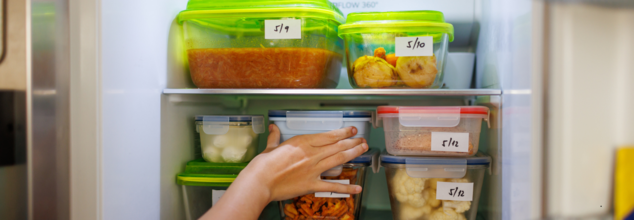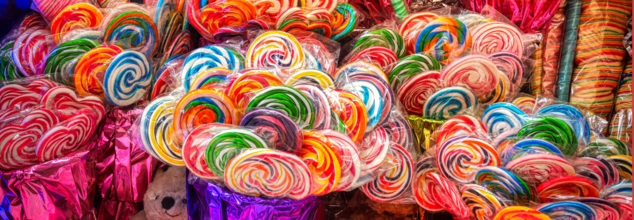
Credits: Canva
The Golden Rule To Deal With Leftovers
Food. We all love it. Many times, we prepare more food than required or order more food than we actually need. The our savior, we have refrigerator. But is it safe to keep your leftovers in the fridge? How long must you wait before you put your food in the fridge? Or, how many times can you reheat your food? Today, we will answer all your questions. These are some of the ways you can deal with your leftovers, ensuring that it stays safe even when you eat it again.
When Should You Refrigerate Your Leftovers?
The bacteria that causes food poisoning grows quickly, especially when it is at room temperature. The best way to make sure that your food does not go bad is to put it in fridge within 2 hours after it has been cooked or taken off the heat. If it is really hot outside, like it is during the peak summers, it is best that you put your food in the fridge in 1 hour of having it prepared.
Should You Cool Your Hot Foods Before Putting It In Your Fridge?
Not really. You actually do not need to wait until the leftovers are room temperature. In fact, you can put the hot foods directly into the fridge. When you have a large amount of food, especially in a pot, it may take a lot of time to bring it back to the room temperature. What you can do is, put them in leak-proof container and then put the container in a bowl of water to cool it down quickly. However, the only reason one waits for food to cool down a bit before putting it in the fridge is so the temperature does not affect the pot, leading it to breaking it. But as long as food is your concern, it does not go bad.
What Should Be Your Fridge's Temperature?
More than a third of Americans have too-warm refrigerators. This can lead to bacteria growth. What you must make sure is that your fridge is set to 40 degrees Fahrenheit or below. The freezer should be at 0 Fahrenheit or below.
Leftovers: Until When Are They Safe?
Most of us think that leftovers are safe until they start to smell. While it is true that if your food smells, you must immediately throw it out. However, why the wait? What you must do is, if your food is waiting in your fridge for 3 to 4 days, even if it is not smelling, you must still take it out. The best way to protect your food is to always seal it in leak-proof and airtight containers.
Eating cold leftovers, especially cold pizza is fun, but it is not safe for you. To be safe, it is best that you avoid eating cold food, and reheat it at least up to 165 Fahrenheit.
If you have frozen food and you want to thaw it, avoid using hot water on it. It can actually make the bacteria grow much faster. What can you do instead? It is a three-step process. Start with shifting your food from freezer to the fridge, then put it in cold or room temperature water and then microwave it.
Another thing that most of us do is to reheat our food in a slow cooker. This means that your food stays between 40 to 140 Fahrenheit for too long. Instead, what you can do is microwave it, or bake it. Do not worry, you can always freeze your leftover food more than once. However, what you must make sure is that every time you deal with your leftover food, you follow the process that keeps your food and your health safe.

Credits: Canva
Trump Administration Targets To Remove Artificial Food Dyes From Food Supply; How Food Dyes Harming Your Health?
The Trump administration will impose a ban on the synthetic dye industry by working to eliminate artificial food coloring from the American food supply but this isn't about politics—this is about your plate, your family's health, and a system that has let petroleum-based chemicals dictate what our food looks like for decades. Though these artificial colors enhance the appearance of foods, there is increasing concern about what they might be doing to our bodies. From lunchboxes to dessert shelves, artificial food dyes are ubiquitous—and now, they're at the center of a heated national debate.
The plan, as laid out in a media advisory by the U.S. Department of Health and Human Services (HHS), will be officially rolled out by HHS Secretary Robert F. Kennedy Jr. and U.S. Food and Drug Administration (FDA) Commissioner Marty Makary. This marks a major federal move in an emerging national dialogue regarding food safety and public health.
Artificial food coloring has been the target of suspicion for decades. In January, during the Biden administration, the FDA acted decisively by prohibiting Red Dye No. 3 in food, drinks, and ingestible medications based on animal studies that found the additive caused cancer. But that was just one of numerous synthetic coloring agents still widely used in the U.S. food supply—often in brightly colored processed foods, cereals, candies, and even medication.
Now, the Trump administration seems to be focusing on a wider category of petroleum-based synthetic dyes, such as Red No. 40, Yellow No. 5, and Blue No. 1. They are intended to add visual attractiveness but have become more and more linked to health hazards, especially among children. With a bipartisan group of legislators demanding reform, including a recent historic food dye ban signed into law in West Virginia, the push for stronger regulation is picking up speed.
What are Artificial Food Dyes?
Artificial food dyes are man-made chemicals created to duplicate the natural color. Made mostly from petroleum, they are more inexpensive to manufacture and less likely to spoil in grocery stores than natural dyes. Yet, their chemical composition is a cause for concern. Chemicals such as benzidine and 4-aminobiphenyl—both of which are found in common dyes—are known carcinogens under World Health Organization classification.
According to the Center for Science in the Public Interest (CSPI), Americans are consuming five times more synthetic food dye today than in 1955. Their pervasiveness in low-nutrient, ultra-processed foods means that even consumers trying to make healthier choices may be unknowingly ingesting these chemicals.
Research shows that Red No. 3, Red No. 40, Blue No. 2, and Green No. 3 have all been linked to cancer in animal studies. Other dyes, such as Yellow No. 5 and Yellow No. 6, have been reported to induce hypersensitivity reactions and behavioral disturbances in children. U.S. and UK studies have established a high correlation between food dye intake and hyperactivity, irritability, and impaired memory performance in children—even those without a diagnosis of ADHD.
The effort to restrict food dyes is not limited to a single political party. Indeed, Republican and Democratic legislators in over 25 states are proposing or co-sponsoring bills that restrict the use of artificial food coloring. This movement has established a patchwork of state-by-state regulations that industry executives now claim need federal harmonization.
Organizations such as the National Confectioners Association and the Consumer Brands Association have recognized increasing consumer anxiety, but assert that the FDA is best suited to spearhead national food safety efforts. Yet, public confidence in these agencies has been undermined over time, especially as food dye prohibitions in nations throughout Europe are juxtaposed with more sluggish action in the U.S.
In the EU, for instance, foods with artificial dyes are required to have a warning label. Most large U.S. food companies have already reformulated products sold in European markets with natural colorants—but still sell the artificial versions in the United States.
What Are Dyes Made Of?
Food dyes are categorized into two main types—natural and artificial. Although both are used to add color to foods and beverages, their sources and health effects are quite different.
Natural Dyes
These are sourced from natural food origins and plant-derived products. They are deemed safer and commonly exist in organic or low-processing foods.
Examples of natural colorings include:
- Turmeric – Imparts a yellow color; applied to mustards, curries, and snack foods.
- Beet juice or beet powder – Provides a red or pink color.
- Annatto – Vegetable dye derived from achiote seed, a traditional source for orange coloration of cheese and butter.
- Paprika extract (Capsanthin) – Produces intense red or orange shade.
- Carotenes – Derived from carrot, sweet potatoes, or similar root vegetables; imparts an orange hue.
Artificial Dyes
Synthetic or artificial food coloring is produced from petroleum-derived chemical substances. They are commonly used in processed foods because they have a strong color, are inexpensive, and are shelf-stable.
Some common artificial dyes are:
- Red No. 3 (Erythrosine) – Used in candies, popsicles, toaster pastries, and gummy vitamins.
- Red No. 40 – Used in cereals, snack foods, and drinks.
- Yellow No. 5 and No. 6 – Used in chips, cheeses, and candies.
- Blue No. 1 and No. 2 – Common in baked goods and sports drinks.
- Green No. 3 – Used in mint-flavored or pistachio-flavored products.
These artificial dyes are not only used for their appearance, but to cover up processing inconsistencies or to enhance foods to appear more appealing—particularly in foods with little nutritional value such as sodas, candies, and snack foods.
Health Risks of Food Dyes
While hyperactivity and behavioral problems in children tend to grab most of the headlines, artificial dyes may have broader implications. A number of dyes have been associated with immune suppression, gut irritation, and cellular toxicity. Low doses—in as little as one milligram—have been shown to cause symptoms of restlessness and insomnia in hypersensitive people.
The issue isn't just with colored candies, either. Artificially colored dyes are present in cough medicines, gummy multivitamins, sports beverages, toaster tarts, and even processed deli meats—foods where coloring may not even be readily visible to consumers.
Erythrosine, the chemical used in Red No. 3, is most controversial. Frequently found in foods such as red popsicles, toaster pastries, and some fruit drinks, it is a proven carcinogen in laboratory rats. Critics believe that ongoing use of such additives in children's foods is immoral and preventable.
Potential Cancer Risks
Red Dye No. 3 was also implicated in causing thyroid tumors in animal tests, and it is banned in the U.S. in cosmetics—though not yet in foods until recent action by the FDA.
Red 40, Yellow 5, and Yellow 6 contain minute amounts of benzidine and 4-aminobiphenyl, both identified human carcinogens.
Behavioral and Neurological Concerns in Children
Several studies have identified connections between artificial dyes and children's behavioral problems:
A U.S. study in Science reported that children performed less well on memory tests after eating a combination of food dyes.
A 2007 study in The Lancet showed that children became hyperactive within an hour of eating synthetic dye combinations—even if they didn't have ADHD.
Hyperactivity and restlessness – Particularly in children who are sensitive to dyes such as Yellow No. 5.
Sleep disturbances and irritability – Even minimal doses (as little as 1 mg) can cause reactions in sensitive people.
Allergic reactions – Certain dyes have been linked with allergy-like reactions such as skin rashes and asthma worsening.
Gastrointestinal disturbances – Anecdotal evidence has connected synthetic dyes with bloating, nausea, and stomach pain in sensitive people.
Long-Term Exposure and Cumulative Impact
Americans today consume five times more synthetic food dyes than they did in the 1950s. This cumulative exposure, particularly in children, has raised questions about long-term health effects that are still not well-studied.
Although no one responds uniformly to artificial food coloring, and in moderation is still the rule, the mounting scientific evidence—and consumer worry—have led government agencies and researchers to reassess the safety of these additives.
Natural Substitutes for Food Color Dyes
Fortunately, safer and natural substitutes do exist. Dyes created using beet juice, turmeric, annatto extracts, and paprika are now readily available and applied to organic and whole-food products. USDA-certified organic is a sound signifier that the product contains no artificial dyes.
However, transparency in the food industry continues to be a problem. Such labeling as "color added" or "artificial color added" usually hides the use of synthetic dyes. Consumers with an education level need to closely read ingredient panels and become familiar with dye numbers and names to make intelligent decisions.
The Trump administration's push to ban artificial food colorings is a turning point in the changing dialogue regarding food safety. As more information comes out and public awareness increases, pressure will build on regulators and manufacturers to respond.
While some scientists advise caution that further research is required to create definitive cause-and-effect relationships in humans, the evidence is piling up—and becoming increasingly difficult to ignore.

Credits: Canva
Your Daily Drinks May Reduce Your Risk Of Health And Neck Cancers But Only If You Drink This Much
If your morning doesn't start without a hot cup of coffee or soothing sip of tea, you may be getting something more than just a morning boost. New research shows that your daily cup might actually lower your risk of head and neck cancers—a category of diseases that includes mouth, throat, and voice box cancers. But how much should you consume to gain these possible benefits? And is there ever too much? Let's deconstruct.
Head and neck cancers (HNC) include malignancies of the oral cavity, oropharynx, hypopharynx, larynx, nasal cavity, and sinuses. Although improvements in early diagnosis and treatment have enhanced survival, the rate of some types—particularly oropharyngeal cancer—has climbed steadily. The burden is especially onerous in low-income nations, where prevention and access are still limited.
This increasing interest has led researchers to look into preventive measures, particularly those that are related to daily habits. Among them, drink preferences such as coffee and tea are now being investigated not only for their antioxidant activity, but also for their ability to reduce cancer risk.
A study using 14 international studies, completed by researchers at the International Head and Neck Cancer Epidemiology Consortium, determined that heavy coffee drinkers could lower their risk of head and neck cancers substantially. In Cancer, a publication of the American Cancer Society, the research presented strong figures:
Consuming over 4 cups of caffeinated coffee daily was linked with a
- 17% decrease in overall risk of head and neck cancers
- 30% decrease in risk of oral cavity cancer
- 22% decrease in risk of oropharyngeal cancer
And even more remarkably, those who drank 3–4 cups every day had a 41% lower chance of getting hypopharyngeal cancer, a rare and dangerous cancer located close to the voice box.
Notably, decaffeinated coffee also produced some protective results. People with up to a daily 1 cup of decaf intake were 25% less likely to develop oral cavity cancer. It indicates that this potential protective value may not come from caffeine itself, but could be in another plant component or polyphenolic compound contained within coffee.
The results with tea also indicated some encouraging associations for lower risk for cancer, albeit the results were not as unidirectional and consistent as the case of coffee.
The research indicated that tea drinking had a complex relationship with head and neck cancer risk. Those who consumed up to one cup of tea daily experienced significant protective effects, such as having a 9% lower overall risk of head and neck cancers and a 27% decreased risk of hypopharyngeal cancer. These observations imply that moderate consumption of tea may play a positive role in preventing cancer. Yet the data also presented a fatal qualifier: having more than a single cup of tea per day was linked with a 38% higher risk of laryngeal cancer. This is the message that when tea is involved, more does not always equate to better. It reiterates the need for caution and points towards the idea that tea's role in preventing cancer could lose efficacy or even backfire—when taken excessively.
Dr. Yuan-Chin Amy Lee, lead author of the study, highlighted this nuance:
"Coffee and tea habits are pretty complicated. While we do see some protective effects, especially with certain kinds of cancer, how it works depends on the amount of coffee or tea consumed and the specific cancer subtype."
Why Coffee and Tea May Help?
Both tea and coffee are good sources of antioxidants, polyphenols, and other bioactive molecules that will aid in battling inflammation and oxidative stress—conditions known to advance cancer development.
Coffee consists of chlorogenic acids and diterpenes such as cafestol and kahweol, which were found in experiments to suppress the growth of tumors. Tea, especially green tea, consists of catechins like EGCG (epigallocatechin gallate), which also possesses anti-cancer potential.
It's probably a synergy of these compounds acting together, not caffeine alone, that provides a protective effect.
When is it Too Much?
Though promising, experts caution against excessive intake. Consuming 3–4 cups a day seems to be the optimum for cancer protection. But going beyond this interval may not have added benefits—and may even produce side effects such as insomnia, stomach upset, or elevated heart rate in some people.
For tea, moderation is particularly necessary. Although as much as 1 cup a day appears to be good for you, more than that—especially with some varieties such as very strong black tea or sweet milk teas—can be dangerous.
How to Drink Coffee and Tea Without Damaging Your Health?
To get the most benefit and least risk, follow these guidelines when adding coffee and tea to your daily routine:
1. Stay within the Safe Zone
Shoot for no more than 3–4 cups of coffee daily.
Restrict tea consumption to 1–2 cups, particularly if you drink black or strong teas.
2. Watch the Additives
Steer clear of adding lots of sugar, syrups, or full-fat creamers, which will negate the health benefits.
Stick to plant-based milk or a dash of low-fat milk if necessary.
3. Time It Right
Steer clear of consuming coffee late in the day to avoid disrupting sleep.
For coffee, herbal teas in the evening (such as peppermint or chamomile) can be a suitable substitute.
4. Balance is Key
Don't get stuck on beverages alone for preventing disease.
Eat a nutrient-dense, antioxidant-rich diet packed with vegetables, fruits, whole grains, and lean proteins.
5. Listen to Your Body
If you feel jittery, have heartburn, or get anxious, reconsider your caffeine use. Decaffeinated coffee can still provide benefits with fewer side effects.
Although additional research is necessary to fully clarify the intricacy of the relationship between these ubiquitous drinks and cancer risk, this new information adds a welcome twist to the tale. Your morning coffee or thoughtfully selected tea may be doing more than merely getting you on your feet. It may be working quietly, on a regular basis, to reduce your cancer risk, especially for some of the most aggressive types of head and neck cancers.

Credit: Canva
Just Half Cup Of This Berry Can Boost Your Cognition, Memory
Have you ever wondered about the health benefits of those tiny blue bursts of flavour that you add to your smoothie or to your breakfast cereals? Blueberries are packed with nutrients and antioxidants that offer a range of benefits, particularly to your stomach and gut. Now, a new study has found that it has significant benefits to your intelligence and cognition, too.
The study published in Nutrients found that participants who ate just half a cup of blueberries a day for 12 weeks experienced improvements in learning, memory, executive function decision-making, planning, focus, task management, etc.
This is particularly noteworthy because executive function governs our ability to stay organized, make informed decisions, and follow through on tasks—skills that often begin to wane with age. It is incredible that something as simple and accessible as blueberries could influence these areas in just a matter of weeks.
Why? Blueberries are rich in antioxidants and other bioactive compounds (chemicals that promote good health). Specifically, blueberries are packed with anthocyanins, an antioxidant that improves metabolic function, increases cell-level energy production, and decreases inflammation.
These compounds are naturally occurring pigments that give blueberries their deep colour, and they do more than just look pretty—they work on a cellular level to reduce oxidative stress, which is one of the factors believed to contribute to age-related cognitive decline.
That’s especially important if you’re somewhat overweight. Generally speaking, metabolic disturbance accelerates in middle age and is a prominent risk factor for dementia. Unfortunately, those who are overweight or otherwise insulin-resistant have an elevated risk for future dementia.
So, for those trying to take proactive steps against cognitive decline, blueberries offer a simple, natural solution. Not a miracle cure—but an effective supplement to an overall healthy lifestyle. The demonstration of these benefits … suggests that ongoing blueberry supplementation may contribute to protection against cognitive decline when implemented early. Or in non-researcher-speak, half a cup of blueberries a day improved the average participant’s language skills, improved their short-term memory, and enhanced their decision-making, planning, and organisational skills.
As an added bonus, participants also experienced lower fasting insulin levels, which means their ability to process carbohydrates efficiently (an important aspect of overall metabolic health) had also improved.
Genetics Matter Too
Sounds too good to be true? Granted, blueberries aren’t magic. Genetics also matter. Beyond that, considerable research shows diet, exercise, and a healthy lifestyle make the biggest impact on improving — or at the very least maintaining — the effect of ageing on cognition and memory.
A healthy diet can reduce age-related cognitive decline and the risk of developing various neurodegenerative diseases.
Exercise can slow or even reverse the physical decay of your brain. Research shows exercise can increase the size of your hippocampus even in your 60’s and 70’s, helping to mitigate the impact of age-related memory loss.
As for lifestyle, insufficient sleep is associated with accelerated brain atrophy and impaired brain functional connectivity. Alcohol, tobacco, and other drugs directly impact the brain, causing it to age more rapidly, atrophy, and lose functioning ability.
So, yeah: If your diet sucks, you never exercise, and you smoke, drink, and don’t get enough sleep, blueberries are just a drop in the learning, memory, and executive function bucket.
But they can help.
Plus, adding one positive habit to your lifestyle may help you more easily add additional positive habits to your lifestyle. Psychologists call it the spillover effect: the way making one positive choice, no matter how small, inspires you to make other positive choices. The way focusing on improving one thing, no matter how small, will naturally and even effortlessly lead to making improvements in other areas.
© 2024 Bennett, Coleman & Company Limited

